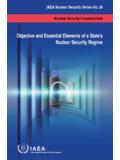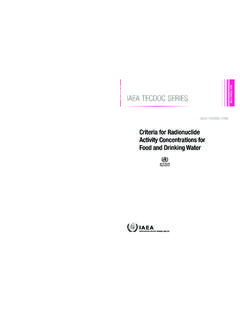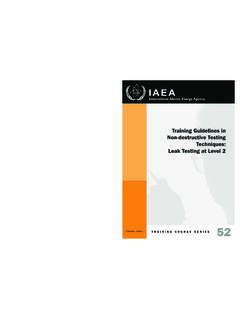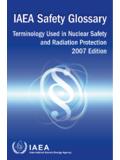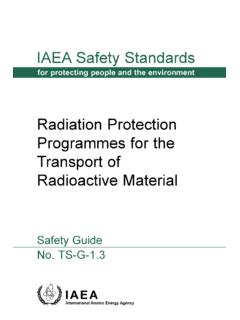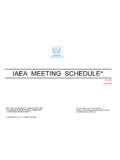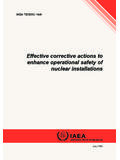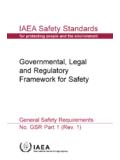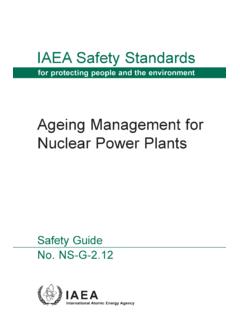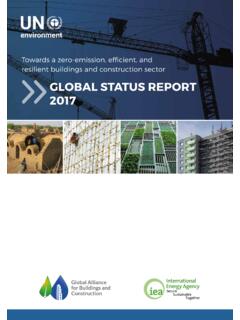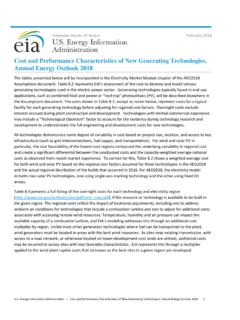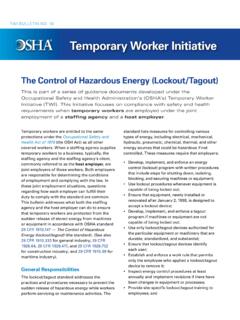Transcription of World Distribution of Uranium Deposits (UDEPO) with ...
1 IAEA-TECDOC-1629 World Distributionof Uranium Deposits (UDEPO)with Uranium Deposit Classification2009 EditionIAEA-TECDOC-1629 World Distributionof Uranium Deposits (UDEPO)with Uranium Deposit Classification2009 Edition The originating Section of this publication in the IAEA was: Nuclear Fuel Cycle and Materials Section International Atomic energy agency Vienna International Centre Box 100 1400 Vienna, Austria World Distribution OF Uranium Deposits (UDEPO) WITH Uranium DEPOSIT CLASSIFICATION IAEA, VIENNA, 2009 IAEA-TECDOC-1629 ISBN 978 92 0 110509 7 ISSN 1011-4289 IAEA, 2009 Printed by the IAEA in Austria October 2009 FOREWORD Having comprehensive information on the worldwide Uranium Deposits is crucial for implementation of significant nuclear power programmes in the World , especially with the increasing interest in nuclear power and concerns about the supply of energy resources. Starting from the early years of the development of nuclear energy for peaceful uses, the International Atomic energy agency has published numerous reports on different types of Uranium Deposits , their geological characteristics and geographical Distribution .
2 With the increased amount of information available on Uranium Deposits throughout the World , the IAEA was able to establish an electronic database and publish it in the form of an Atlas in 1995. The atlas later was supported with a World Guidebook to Accompany IAEA Map: World Distribution of Uranium Deposits , in the form of a databook in 1996. The name of the database was World Distribution of Uranium Deposits (UDEPO). The UDEPO database was revised and expanded in 2004 to store to provide more detailed information on Uranium geology and technical characteristics of the Deposits . The revised database has been published on the internet since 2004. The database and its web site are being updated continuously. This report and its attached CD-ROM contain information on 878 Uranium Deposits worldwide and reflect a snapshot of the database as of end of 2008. The database itself is being updated continuously. The reader can access the most up to date information at The IAEA wishes to thank the consultants who took part in the preparation of the UDEPO database.
3 The IAEA is also grateful to the Member States and individual organizations for their generous support in providing experts and data to make this database more complete. The IAEA officer responsible for this publication was M. Ceyhan of the Division of Nuclear Fuel Cycle. EDITORIAL NOTE The use of particular designations of countries or territories does not imply any judgement by the publisher, the IAEA, as to the legal status of such countries or territories, of their authorities and institutions or of the delimitation of their boundaries. The mention of names of specific companies or products (whether or not indicated as registered) does not imply any intention to infringe proprietary rights, nor should it be construed as an endorsement or recommendation on the part of the IAEA. CONTENTS 1. INTRODUCTION .. 1 1 Purpose and Scope of 1 Definitions .. 4 Resource categories .. 4 Deposit types.
4 4 Deposit 8 UDEPO database structure .. 9 Data included .. 9 Overview of Uranium resources, production and 11 2. Uranium DEPOSIT 15 Unconformity related 15 15 Geologic setting of Jabiluka, Australia and Cigar Lake, Canada .. 16 Ore geometry and 19 Uranium resources and production in unconformity related Deposits .. 20 Sandstone 21 21 Roll front type 22 Tectonic-lithologic type 25 Basal channel type 28 Tabular sandstone type Deposits .. 30 Hematite Breccia Complex 33 33 Geologic setting of Olympic Dam Deposit, 33 Ore geometry and metallogenesis of Olympic Dam Deposit, 35 Uranium resources and production in Olympic Dam 37 Quartz-pebble conglomerate Deposits .. 37 37 Geologic setting of Witwatersrand district, South 38 Ore geometry and metallogenesis of Witwatersrand district, South 38 Uranium resources and production in Witwatersrand 39 Vein type (granite related U Deposits ).
5 39 39 Geologic setting of Margnac, France and J chymov, Czech Republic 40 Ore geometry and metallogenesis of Margnac, France and J chymov, Czech Republic 41 Uranium resources and production in Margnac, France and J chymov, Czech Republic 42 Intrusive 43 43 Geological setting of R ssing deposit, 44 Ore geometry and metallogenesis of R ssing deposit, Namibia .. 45 Uranium resources and production in R ssing deposit, 45 Caldera related volcanic Deposits .. 45 45 Geologic setting of Streltsovskoe deposit, Russian 46 Ore geometry and metallogenesis of Streltsovskoe deposit, Russian 49 Uranium resources and production in Streltsovskoe deposit, Russian 47 Metasomatic Deposits .. 47 47 Uranium Deposits in albitites .. 48 Uranium Deposits in potassium metasomatites (elkonites).. 49 Surficial Deposits .. 53 53 Geologic setting of Yeelirrie deposit, Australia.
6 54 Ore geometry and metallogenesis of Yeelirrie deposit, 54 Uranium resources and production in Yeelirrie deposit, Australia .. 56 Collapse breccia pipe 56 56 Geologic setting of Arizona 56 Ore geometry and metallogenesis of Arizona strip .. 56 Uranium resources and 57 Phosphorite 58 58 Geologic setting .. 59 Ore geometry and 60 Uranium resources and production in phosphorite 61 Black shale 61 61 Geologic setting of Ranstad Deposits , Sweden .. 61 Ore geometry and metallogenesis of Ranstad Deposits , 61 Uranium resources and production from Ranstad Deposits , 62 Metamorphic Deposits [Example: Mary Kathleen deposit, Queensland, Australia] .. 62 62 Geologic setting of Mary Kathleen deposit, Queensland, 62 Ore geometry and metallogenesis of Mary Kathleen deposit, Queensland, 63 Uranium resources and 65 Other deposit types .. 65 Uraniferous coal and lignite 65 Limestone and paleokarst Deposits .
7 66 By-product copper processing .. 66 3. World Distribution OF Uranium 66 UDEPO 66 Deposit 66 Deposit 67 Country 67 Worldwide summary tables .. 69 Directory of Uranium 69 The list of Uranium Deposits : Sorted by country and name (as of March 2009).. 69 Initial resources by country and deposit type .. 89 Deposit numbers by country and deposit 92 Deposit numbers by country and deposit 95 Grade Distribution by deposit 98 Initial resource Distribution by deposit type .. 98 Deposit status Distribution by deposit 99 4. 100 101 111 CONTRIBUTORS TO DRAFTING AND REVIEW .. 117 00 1. INTRODUCTION Background In 1996, the IAEA published the Guidebook to Accompany IAEA Map: World Distribution of Uranium Deposits (the Guidebook ). This publication, which was the culmination of a process that began in 1990, introduced a descriptive deposit classification that expanded upon the classification used in the OECD/NEA-IAEA Red Book.
8 Experts from six countries and from the IAEA collaborated on establishing the deposit classification. They also contributed information on a total of 582 Deposits worldwide, and provided summary information on these Deposits that became part of the Guidebook including their location, status (operating, dormant, depleted, etc.), resources (within a specific resource range 1 500 to 5 000 t U), average grade (within a grade range U), geologic age, host rocks and tectonic setting. Provision is also made in the database to record references relating to the Deposits and to include maps and photos of Deposits . To have been included in the database, a deposit must have minimum resources of >500 t U at an average of U or greater (note: exceptions to these guidelines have been allowed in a small number of cases where small Deposits occur near operating or proposed production centres).
9 The deposit-specific information, a map showing deposit locations [1] and a discussion of the new deposit classification were published in the 1996 Guidebook [2]. The Guidebook and the database on which it is based have come to be known collectively as UDEPO. The database was created on a computer based system to allow publishing above mentioned product easily. Major modification has been implemented on UDEPO database in 2004. The database has been moved to MS SQL relational database server to allow building client/server architecture applications so that multiple users are able to access to the database at the same time. Another advantage of having database on the server is ability to update continuously. This has also allowed publishing the database through the internet. A web application has been developed and made available to the public access in 2004 ( ) [3]. The UDEPO database and its web site have been continuously updated and improved since then.
10 As of end of 2008 there are 873 Deposits recorded in the database. Purpose and Scope of UDEPO In 2002, the IAEA began an effort to integrate all nuclear fuel cycle related databases and computer simulations to make them more readily accessible to the Member States. A consultants meeting was held in 2003 to establish guidelines for restructuring UDEPO to ensure that it would be compatible with the integrated database approach. Assembling UDEPO data into a new structure began in 2003. A website, which was developed to publish the database, became available to the public in February 2004. The site has been periodically revised based on feedback from users and recommendations from consultants. A consultants meeting was held in 2005 to establish guidelines for a publication that would update and expand upon the original Guidebook. In addition to becoming part of the IAEA integrated database approach and thus readily available to Member States, the update was considered to be very timely, because since the inception of the UDEPO process in 1990 and publication of the Guidebook in 1996, the Uranium industry has undergone significant changes.
